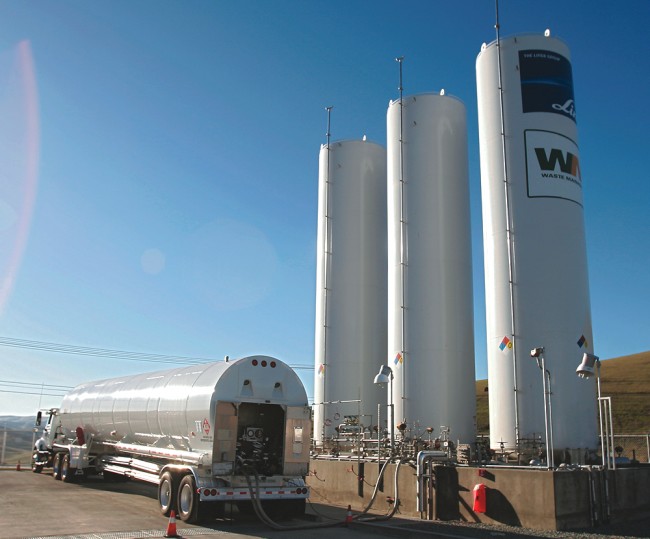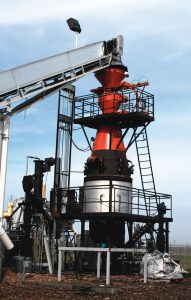Bioenergy development is back in gear in California, fueled by political and industry leadership.
Julia Levin
BioCycle April 2013, Vol. 54, No. 4, p. 45

An example of opportunities for bioenergy developers is a landfill biogas to LNG fueling facility in Altamont Pass, developed under a joint venture between Waste Management and Linde North America — with technical support from the Gas Technology Institute and funding from the California Energy Commission.
California has the most ambitious recycling, renewable energy and low carbon fuel requirements in the nation. Yet the state produces only 2 percent of its electricity from biomass and an even smaller percentage of its transportation fuels from organic waste. Despite some early successes for biomass and biofuels in the 1980s and 1990s, new bioenergy development in California had largely stalled. High costs, environmental concerns and other sustainability issues all hurt the industry. The recent focus on solar and wind power, combined with low natural gas prices, has not helped either.
But, bioenergy development is back in gear in the state, due primarily to political and industry leadership. In Sacramento, Governor Arnold Schwarzenegger recognized the many benefits of bioenergy and adopted an Executive Order in 2006 and other policies to promote it. He set ambitious targets for biomass and biofuels and brought state agencies together to achieve those targets. California’s plan to reduce greenhouse gas emissions under AB 32, the Global Warming Solutions Act (passed in 2006), also relies heavily on bioenergy to capture methane emissions, produce low carbon fuels, reduce organic waste and maintain forest carbon sequestration. The Brown Administration and California Legislature have expanded on these initiatives and California is now, finally, poised for major growth in the bioenergy industry.
The market potential is enormous. The California Energy Commission has calculated that bioenergy could provide 44,300 gigawatt hours of renewable electricity in California. That’s nearly 6,000 megawatts (MW), or 10 percent, of California’s total electricity capacity. California currently generates about 1,000 megawatts of electricity and 48 million gallons of biofuels from organic waste and biogas emissions. With the organic waste and biogas emissions currently available in the state, bioenergy could produce an additional 5,000 MW of renewable electricity or 1.37 billion gasoline gallon equivalents of biofuels for motor vehicles and other purposes. New bioenergy development could produce more than 15,000 new, full-time jobs in California — which is a lot, even in California — and provide a much needed economic boost, especially in rural areas of the state with few economic alternatives. In fact, bioenergy produces more construction jobs per megawatt than fossil fuels, and more operations and maintenance (O&M) and fuel treatment jobs than any other form of energy (Kammen et al, 2004).
For bioenergy developers, waste producers and resource agencies, this growth can’t happen fast enough. As the country’s biggest agricultural, dairy and food producing state, California produces a lot of waste — nearly 40 million tons per year. Much of that waste goes to landfills, is burned in open fields or flared, or is simply allowed to decompose without being put to more beneficial uses. California’s forests, which cover nearly half the state, also contain enormous amounts of forest fuel that pose grave wildfire risks if not treated. Bioenergy is the most beneficial use of these organic wastes, especially when combined with the production of compost and other beneficial by-products.
The waste industry is already familiar with the many benefits of bioenergy, but many others outside of that industry are not. Bioenergy can significantly reduce air, water and odor pollution from urban, agricultural and dairy waste. It also reduces pollution by replacing fossil fuels used to generate electricity and providing a much cleaner alternative to diesel and other transportation fuels. Bioenergy addresses environmental justice impacts — the disproportionate public health impacts in low income communities — by reducing waste, diesel powered truck trips and fossil fuel powered electricity. And bioenergy from forest waste protects public health and safety by reducing the risks and impacts of catastrophic wildfires.
Bioenergy Actions
As noted, 2012 was a pivotal year for the bioenergy industry. The Brown Administration adopted the 2012 Bioenergy Action Plan, which includes 55 specific actions that state agencies must take to accelerate bioenergy development. The actions focus on increasing sustainable biomass production, streamlining and consolidating permitting requirements, increasing R&D, and incentivizing and monetizing the benefits of bioenergy. The 2012 Bioenergy Action Plan is available at: www.energy.ca.gov/bioenergy_action_plan/.
The California Legislature has also stepped up to promote bioenergy, passing three laws in 2012 that will help bioenergy development. SB 1122 (Rubio) requires California’s utilities to purchase 250 megawatts (MW) of bioenergy from facilities that are 3 MW or smaller. Of the total, the bill requires that the utilities purchase 110 MW from urban organic waste, 90 MW from dairy and agricultural waste, and 50 MW from forest waste. AB 1900 (Gatto) requires new standards for pipeline injection of biomethane, and AB 2196 (Chesbro) clarifies the role of out of state biogas under California’s Renewable Portfolio Standard. Together, the Gatto and Chesbro bills will enable much more biogas production and use in California.

A biomass gasifier in Merced, installed by Phoenix Energy, utilizes forestry residuals among other organic wastes to generate electricity as well as biochar, a soil amendment.
Together, these policies offer unprecedented opportunities for bioenergy development in California. Realizing those opportunities, though, will require coordination among the different bioenergy sectors, participation in numerous proceedings, and outreach to key stakeholders. Several industry leaders and public agencies recognized this need and worked together to form the Bioenergy Association of California (BAC). BAC is now a quickly growing association of bioenergy and waste companies, public agencies, nonprofits and others working together to promote sustainable bioenergy development.
BAC’s policy priorities include successful implementation of the three laws passed in 2012, improved access to transmission lines and pipelines, allocation of clean energy and transportation funds for bioenergy, allocation of cap and trade funds, and passage of organics diversion legislation. BAC will also coordinate outreach to policymakers and key stakeholders to increase understanding of bioenergy’s benefits and challenges, and will work with the research community to promote critical R&D needs. Finally, BAC will work with California’s utilities to facilitate project development and a more effective permitting framework.
Julia Levin is Executive Director of the Bioenergy Association of California. Learn more about BAC and bioenergy generally in California, www.bioenergyca.org.
Reference
Kammen, D.M., K.Kapadia and M. Fripp, 2004. Putting renewables to work: how many jobs can the clean energy industry generate? Report of the Renewable and Appropriate Energy Laboratory, University of California, Berkeley, CA.










